JavaScript is disabled for your browser. Some features of this site may not work without it.
Buscar en RiuNet
Listar
Mi cuenta
Estadísticas
Ayuda RiuNet
Admin. UPV
Relaciones entre densidades y biomasas de Salmo trutta fario y mediciones del mesohabitat en tramos trucheros de la Comunidad Valenciana
Mostrar el registro completo del ítem
Alcaraz-Hernández, JD.; Martinez-Capel, F.; Peredo Parada, MM.; Hernández Mascarell, AB. (2007). Relaciones entre densidades y biomasas de Salmo trutta fario y mediciones del mesohabitat en tramos trucheros de la Comunidad Valenciana. Limnetica. 26(1):159-167. http://hdl.handle.net/10251/33352
Por favor, use este identificador para citar o enlazar este ítem: http://hdl.handle.net/10251/33352
Ficheros en el ítem
Metadatos del ítem
| Título: | Relaciones entre densidades y biomasas de Salmo trutta fario y mediciones del mesohabitat en tramos trucheros de la Comunidad Valenciana | |
| Autor: | Alcaraz-Hernández, Juan Diego Peredo Parada, Matías Manuel Hernández Mascarell, Aina Berta | |
| Entidad UPV: |
|
|
| Fecha difusión: |
|
|
| Resumen: |
[EN] In the year 2003, populations of Salmo trutta fario were studied in the Valencian rivers. Habitat conditions were also studied
along the successive hydro-morphological units in 300 m long reaches, along with geographic ...[+]
[ES] En el año 2003 se estudiaron las poblaciones autóctonas de Salmo trutta fario en los ríos valencianos. Por otro lado se
midieron las condiciones del hábitat según las sucesivas unidades hidro-morfológicas en tramos ...[+]
|
|
| Palabras clave: |
|
|
| Derechos de uso: | Reserva de todos los derechos | |
| Fuente: |
|
|
| Editorial: |
|
|
| Versión del editor: | http://www.limnetica.com | |
| Tipo: |
|







